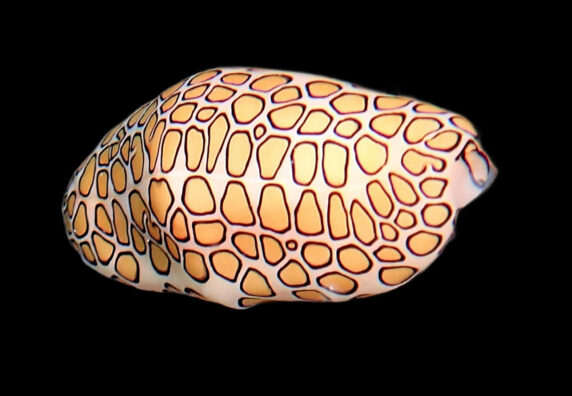Flamingo Tongue Shell, Cyphoma gibbosum
 Flamingo Tongue Shell, Cyphoma gibbosum. Shell collected from coastal waters off Akumal, Quintana Roo, March 2018. Collection and photograph courtesy of Juan Rojo, Akumal.
Flamingo Tongue Shell, Cyphoma gibbosum. Shell collected from coastal waters off Akumal, Quintana Roo, March 2018. Collection and photograph courtesy of Juan Rojo, Akumal.
The Flamingo Tongue, Cyphoma gibbosum, is a gastropod mollusk from the Ovulidae Family of Cowry Allies or False Cowries. They are known in Mexico as caracol lengua de flamenco. The Ovulidae Family is a large family with over one hundred fifty global members that have been placed in more than twenty genera, however, the majority are poorly documented and poorly studied.
The Flamingo Tongue is small in stature but brightly colored that are normally found in colonies of two or three individuals, to help avoid predation, at depths up to 30 m (100 feet). In nature they are a bright orange-yellow color with black markings. Their colors vary significant from animal to animal. Most amateur conchologist collect these animals due their color later to discover that the observed color is from the mantle tissue of the snail which covers the shell and not from its shell which is a uniform white to a yellow-orange without spotting. The mantle is normally extended and retracted only when the snail is under attack. The shells reach a maximum of 4.4 cm (1.7 inches) in length. The shells are thick, elongated with a narrow aperture, smooth in texture, the dorsum exhibits a thick transversal ridge and they have no markings except a longitudinal white or cream-colored band. The exterior of the shell is a reddish-cream to salmon to white and the interior is white or pinkish. Juvenile shells are fragile and transparent taking the color of the host gorgonian for camouflage from predation. Their foot is ivory white with detached irregular black lines radiating toward the black-edged margins.
The Flamingo Tongue Snail feed on the living tissues of gorgonian soft corals, in which they reside, that serve as sites for protection, mating, egg deposition and food. They are ectoparasites that a diurnally active feeding on a variety of gorgonians, by scraping off coral polyps with their radula, leaving a highly visible scar, and move from gorgonian to gorgonian for feeding leaving a mucus trail for their amigos to follow. Reproduction is gonochoric and they reproduce sexually with internal fertilization with the female laying her eggs within mucus nets that are attached to the host coral to which they have recently fed upon. Several hundred planktonic larvae hatch within ten days and eventually settle out in other soft gorgonian corals. The juveniles will hide on the underside of the corals while the adults are highly visible and mobile. They possess toxins, absorbed from the gorgonians on which they feed, which aides in their avoidance of predation by fishes.
Due to its coloration the Flamingo Tongue Snail is easy to identify and cannot be confused with any other species.
The Flamingo Tongue Snail are found throughout the tropical Western Atlantic including all Mexican waters of the Atlantic Ocean.
The Flamingo Tongue Snail has not formally evaluated from a conservation perspective but in heavily visited areas snorkelers and scuba divers over-collect the live animals due to their beauty and their populations have been severely depleted.